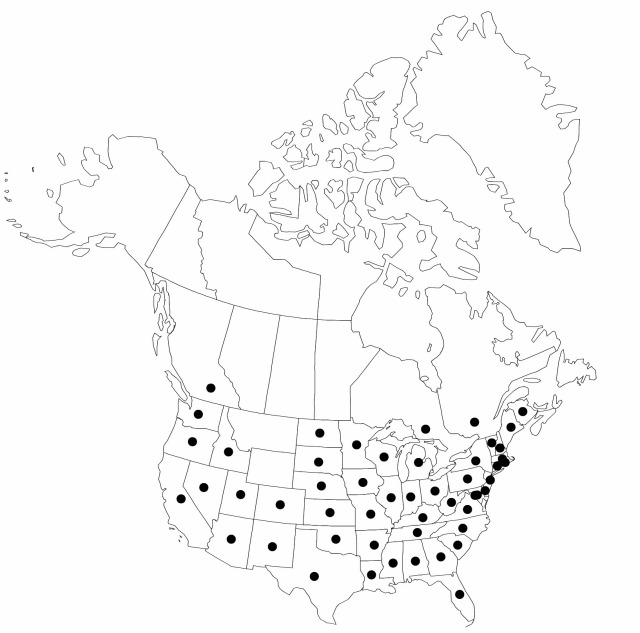Difference between revisions of "Cyperus esculentus"
Sp. Pl. 1: 45. 1753.
FNA>Volume Importer |
RevisionBot (talk | contribs) m (Bot: Adding category Revised Since Print) |
||
| (7 intermediate revisions by 3 users not shown) | |||
| Line 6: | Line 6: | ||
|place=1: 45. 1753 | |place=1: 45. 1753 | ||
|year=1753 | |year=1753 | ||
| + | }} | ||
| + | |special_status={{Treatment/ID/Special_status | ||
| + | |code=W2 | ||
| + | |label= | ||
| + | }}{{Treatment/ID/Special_status | ||
| + | |code=W1 | ||
| + | |label= | ||
| + | }}{{Treatment/ID/Special_status | ||
| + | |code=F | ||
| + | |label=Illustrated | ||
}} | }} | ||
|basionyms= | |basionyms= | ||
| Line 19: | Line 29: | ||
-->{{Treatment/Body | -->{{Treatment/Body | ||
| − | |distribution= | + | |distribution=B.C.;N.B.;Ont.;Que.;Ala.;Ariz.;Ark.;Calif.;Colo.;Conn.;D.C.;Del.;Fla.;Ga.;Idaho;Ill.;Ind.;Iowa;Kans.;Ky.;La.;Maine;Mass.;Md.;Mich.;Minn.;Miss.;Mo.;N.C.;N.Dak.;N.H.;N.J.;N.Mex.;N.Y.;Nebr.;Nev.;Ohio;Okla.;Oreg.;Pa.;R.I.;S.C.;S.Dak.;Tenn.;Tex.;Utah;Va.;Vt.;W.Va.;Wash.;Wis.;nearly worldwide. |
|discussion=<p>Varieties 4 (3 in the flora).</p><!-- | |discussion=<p>Varieties 4 (3 in the flora).</p><!-- | ||
--><p><i>Cyperus esculentus</i> is a widespread and polymorphic species. Although seven varieties have been recognized (G. Kükenthal (1935–1936), recent studies based primarily on spikelet features provided support for four varieties (P. Schippers et al. 1995). <i>Cyperus esculentus</i> var. esculentus is restricted to the Old World.</p> | --><p><i>Cyperus esculentus</i> is a widespread and polymorphic species. Although seven varieties have been recognized (G. Kükenthal (1935–1936), recent studies based primarily on spikelet features provided support for four varieties (P. Schippers et al. 1995). <i>Cyperus esculentus</i> var. esculentus is restricted to the Old World.</p> | ||
| Line 55: | Line 65: | ||
-->{{#Taxon: | -->{{#Taxon: | ||
name=Cyperus esculentus | name=Cyperus esculentus | ||
| − | |||
|authority=Linnaeus | |authority=Linnaeus | ||
|rank=species | |rank=species | ||
| Line 62: | Line 71: | ||
|basionyms= | |basionyms= | ||
|family=Cyperaceae | |family=Cyperaceae | ||
| − | |distribution= | + | |distribution=B.C.;N.B.;Ont.;Que.;Ala.;Ariz.;Ark.;Calif.;Colo.;Conn.;D.C.;Del.;Fla.;Ga.;Idaho;Ill.;Ind.;Iowa;Kans.;Ky.;La.;Maine;Mass.;Md.;Mich.;Minn.;Miss.;Mo.;N.C.;N.Dak.;N.H.;N.J.;N.Mex.;N.Y.;Nebr.;Nev.;Ohio;Okla.;Oreg.;Pa.;R.I.;S.C.;S.Dak.;Tenn.;Tex.;Utah;Va.;Vt.;W.Va.;Wash.;Wis.;nearly worldwide. |
|reference=schippers1995a | |reference=schippers1995a | ||
|publication title=Sp. Pl. | |publication title=Sp. Pl. | ||
|publication year=1753 | |publication year=1753 | ||
| − | |special status= | + | |special status=W2;W1;Illustrated |
| − | |source xml=https:// | + | |source xml=https://bitbucket.org/aafc-mbb/fna-data-curation/src/2e0870ddd59836b60bcf96646a41e87ea5a5943a/coarse_grained_fna_xml/V23/V23_273.xml |
|genus=Cyperus | |genus=Cyperus | ||
|subgenus=Cyperus subg. Cyperus | |subgenus=Cyperus subg. Cyperus | ||
| Line 73: | Line 82: | ||
}}<!-- | }}<!-- | ||
| − | -->[[Category:Treatment]][[Category:Cyperus subg. Cyperus]] | + | --> |
| + | |||
| + | [[Category:Treatment]] | ||
| + | [[Category:Cyperus subg. Cyperus]] | ||
| + | [[Category:Revised Since Print]] | ||
Latest revision as of 18:36, 6 November 2020
Herbs, perennial, stoloniferous; stolons soft, spongy, flexible when dried, 2–8(–15) cm, bearing tubers (3–)6–11 mm diam. Culms trigonous, 15–60 (–100) cm × 0.6–3.4 mm, glabrous. Leaves 3–7, flat to V-shaped or flanged V-shaped, (6–)20–40(–80) cm × 2–4 (–6.5) mm. Inflorescences: spikes broadly ellipsoid to ovoid or hemispheric, (12–)18–30 × (12–)18–35 mm; rachis 4–17 mm; rays 4–10, (0.3–)2–12 cm; bracts (3–)4–5(–7), ± horizontal to ascending at 45(–75)°, V-shaped to flanged V-shaped, (1.5–)5–30 cm × 0.5–4 mm; rachilla persistent, wings hyaline, 0.3–0.5 mm wide. Spikelets (3–)10–20(–28), divaricate or ascending, yellowish brown to dark brown, linear to linear-lanceoloid, compressed-quadrangular, (5–)10–20(–55) × (1.2–)1.4–2(–3) mm; floral scales persistent, 6–34, spreading or appressed, ovate-lanceolate, laterally 7–9-ribbed, laterally yellowish brown to dark brown medially brownish, reddish, or greenish, ovate, or ovate-deltate, medially 3-ribbed, 1.8–2.7(–3.4) × (1–)1.5–1.8(–2.4) mm, apex acute or subacute. Flowers: anthers (1–)1.2–1.5(–2.1) mm; styles (0.7–)1–1.2(–2.2) mm; stigmas (1.2–)1.8–2.3(–4) mm. Achenes (seldom maturing) brown, sessile, ellipsoid, (1.1–)1.3–1.5(–1.6) × 0.3–0.6(–0.8) mm, apex obtuse, surfaces puncticulate.
Distribution

B.C., N.B., Ont., Que., Ala., Ariz., Ark., Calif., Colo., Conn., D.C., Del., Fla., Ga., Idaho, Ill., Ind., Iowa, Kans., Ky., La., Maine, Mass., Md., Mich., Minn., Miss., Mo., N.C., N.Dak., N.H., N.J., N.Mex., N.Y., Nebr., Nev., Ohio, Okla., Oreg., Pa., R.I., S.C., S.Dak., Tenn., Tex., Utah, Va., Vt., W.Va., Wash., Wis., nearly worldwide.
Discussion
Varieties 4 (3 in the flora).
Cyperus esculentus is a widespread and polymorphic species. Although seven varieties have been recognized (G. Kükenthal (1935–1936), recent studies based primarily on spikelet features provided support for four varieties (P. Schippers et al. 1995). Cyperus esculentus var. esculentus is restricted to the Old World.
Lower Taxa
Key
| 1 | Spikelets ascending-erect; floral scales deltate-ovate, widest ca. 1/4–1/3 of length. | Cyperus esculentus var. heermannii |
| 1 | Spikelets divaricate; floral scales ovate to ovate-lanceolate, widest at midlength. | > 2 |
| 2 | Spikelets (1.2–)1.5–2 mm wide; floral scales 1.8–2.7 mm; anthers (1–)1.3(–1.6) mm; styles (0.7–)1–1.2 mm; stigmas (1.2–)1.8(–2.5) mm. | Cyperus esculentus var. leptostachyus |
| 2 | Spikelets 2.4–3 mm wide; floral scales (2.7–) 2.9–3.4(–3.6)mm; anthers (1.2–)1.3–2(–2.1) mm; styles (0.9–)1.3–2(–2.2) mm; stigmas (2–) 2.3–2.8(–4) mm. | Cyperus esculentus var. macrostachyus |